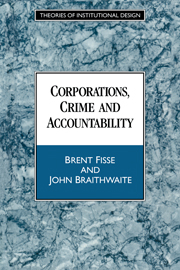Book contents
- Frontmatter
- Contents
- Preface
- Abbreviations
- 1 Crime, Responsibility and Corporate Society
- 2 Individualism
- 3 Enterprise Liability
- 4 Organisation Theory Perspectives
- 5 Making the Buck Stop
- 6 Assessing the Accountability Model
- 7 The Possibility of Responsibility for Corporate Crime
- Bibliography of Cited Works
- Index
6 - Assessing the Accountability Model
Published online by Cambridge University Press: 11 March 2010
- Frontmatter
- Contents
- Preface
- Abbreviations
- 1 Crime, Responsibility and Corporate Society
- 2 Individualism
- 3 Enterprise Liability
- 4 Organisation Theory Perspectives
- 5 Making the Buck Stop
- 6 Assessing the Accountability Model
- 7 The Possibility of Responsibility for Corporate Crime
- Bibliography of Cited Works
- Index
Summary
This chapter takes stock of the Accountability Model by reference to the various desiderata that influence attempts to achieve accountability for corporate crime. We do not contend that the Accountability Model in practice will meet all these desiderata in any case. Indeed, in any particular case trade-offs will have to be made between different desiderata using a framework such as Braithwaite's and Pettit's republican theory of criminal justice, as discussed in Section 5 below. Our contention is that the Accountability Model satisfies more of the desiderata more of the time than current practice or any alternative reform proposal of which we are aware.
We proceed desideratum by desideratum, beginning with the first, which upholds the importance of individual responsibility as a means of social control.
Individual Responsibility as a Pillar of Social Control
Desideratum
A strategy for allocating responsibility for corporate crime should reflect the received wisdom that individual responsibility is a pillar of social control in Western societies. The slide away from individual responsibility in our corporate law enforcement must be remedied.
The Accountability Model that we have suggested would be responsive to the problem of non-prosecution of corporate managers which is now pandemic in modern societies. Justice for individuals would be meted out by private justice systems monitored, as a safeguard against inaction or scapegoating, by the public justice system. This may be the most practicable way of imposing responsibility on those individuals who are primarily responsible.
- Type
- Chapter
- Information
- Corporations, Crime and Accountability , pp. 158 - 217Publisher: Cambridge University PressPrint publication year: 1994
- 16
- Cited by



